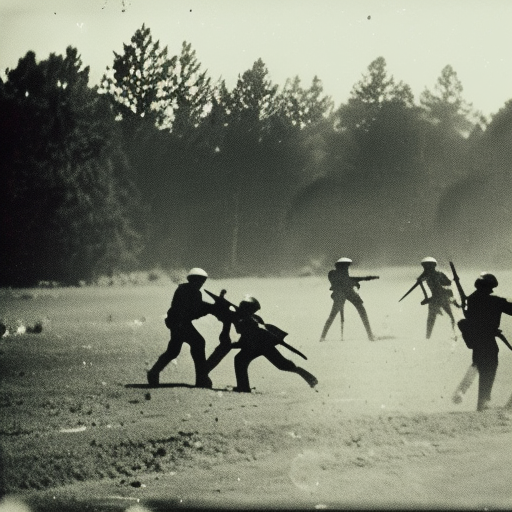Battle of Gembloux: A Decisive Clash in World War II
The Battle of Gembloux, also known as the Battle of the Gembloux Gap, was a significant engagement that took place during the early stages of World War II. Fought between German and Allied forces in May 1940, the battle occurred in the Gembloux Gap, a strategically important area in Belgium.
Background:
By May 1940, Germany had launched its Blitzkrieg campaign and had already conquered Poland, Denmark, and Norway. Now, their sights were set on France and the Low Countries. The Gembloux Gap was a critical area for both sides as it provided a direct route for the German forces to advance towards France. The Allies, primarily consisting of Belgian, French, and British troops, aimed to defend this gap and halt the German advance.
The Battle:
The Battle of Gembloux began on May 14, 1940, when the German Army Group B, under the command of General Fedor von Bock, launched an offensive against the Allied forces. The German forces consisted of armored divisions supported by air superiority. On the other side, the Allies had deployed the French 1st Army and the British Expeditionary Force (BEF) to defend the Gembloux Gap.
The battle unfolded in three distinct phases. In the first phase, the German forces launched a series of powerful armored attacks, aiming to break through the Allied lines. The Allies, though outnumbered and outgunned, put up a fierce resistance. They utilized anti-tank guns and artillery to slow down the German advance, inflicting heavy losses on the enemy.
In the second phase, the German forces regrouped and launched a massive assault on May 15. This time, they focused their attack on the French 1st Army, aiming to divide the Allied forces. The German tanks, supported by Stuka dive-bombers, overwhelmed the French defenses, causing significant casualties and capturing key positions.
Despite the setbacks, the Allies managed to hold their ground and prevent a complete breakthrough. The French 1st Army, though heavily battered, continued to resist and delayed the German advance. The British forces, under the command of General Harold Alexander, provided crucial support, launching counterattacks and holding key positions.
In the final phase of the battle, the German forces renewed their assault on May 16. This time, they concentrated their attack on the British positions. The Germans launched a massive armored assault, but the British troops, supported by artillery and anti-tank guns, fought back fiercely. The British managed to repel the German attack, inflicting heavy losses on the enemy.
Outcome:
The Battle of Gembloux was a significant engagement in World War II. While the Allies suffered heavy losses, they managed to delay the German advance and disrupt their plans. The battle showcased the effectiveness of anti-tank weapons and the resilience of the Allied forces.
The German forces, despite their initial successes, were unable to achieve a decisive breakthrough. The Battle of Gembloux marked a turning point in the German advance towards France. It bought valuable time for the Allies to regroup and strengthen their defenses.
Ultimately, the Battle of Gembloux was a tactical victory for the Germans, but it had strategic implications. The battle demonstrated the effectiveness of combined arms tactics and the importance of coordinated air support. It also highlighted the need for the Allies to strengthen their anti-tank capabilities and improve their coordination.
In conclusion, the Battle of Gembloux was a significant engagement in World War II that took place in May 1940. Fought in the Gembloux Gap, the battle saw German forces launching powerful armored attacks against the Allied defenses. Despite heavy losses, the Allies managed to delay the German advance and disrupt their plans. The battle showcased the effectiveness of anti-tank weapons and the resilience of the Allied forces. While the Germans achieved a tactical victory, the Battle of Gembloux marked a turning point in the German advance towards France and bought valuable time for the Allies to regroup.












